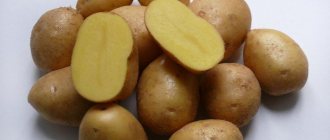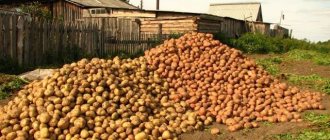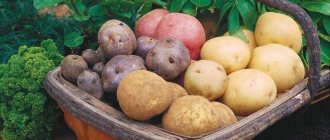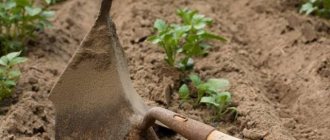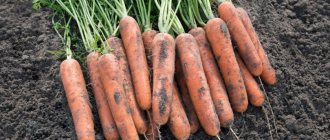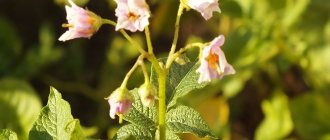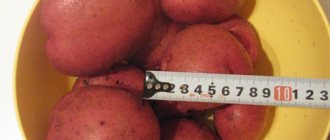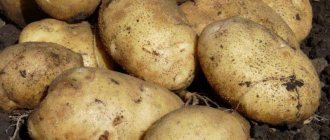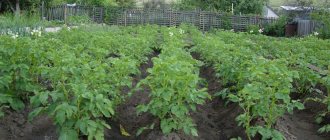Characteristics of varieties
The Dutch potato variety that has taken root in our gardens is different:
- high productivity,
- early stages of tuber formation and crop ripening,
- leveled nest,
- excellent presentation of tubers with small eyes,
- resistance to viral diseases.
These are mainly high-quality varieties for table use.
More than 30 potato varieties from the Netherlands have passed varietal tests at state variety testing sites, are included in the State Register of the Russian Federation, and are recommended for cultivation in certain regions on private farms and farms.
The most famous: “Mona Lisa”, “Asterix”, “Jarla”, “Red Scarlett”, “Ukama”, “Cleopatra”, “Impala”, “Anosta”, “Condor”, “Picasso”, “Provento”, “ Caesar”, as well as “White Dutch” potatoes.
Next, you can read the descriptions of some varieties and their photos.
Features of care
The variety is undemanding in care. Able to survive short dry periods.
Fertilizer and watering
The Dutch woman loves moisture, as she is large-fruited. It is advisable to water it abundantly, but not often. The soil must dry well before the next irrigation procedure.
Weeding and hilling
Weeding and loosening is carried out after each irrigation procedure and rainfall. Potatoes are hilled twice a season: the first time when the bush has reached 15–20 cm in height, the second time - two weeks after the first.
Potatoes "Dutch": description of the variety, photo
Mid-early variety. Productivity from 2 kg per bush. It is highly resistant to viral diseases , common scab, and darkening of the flesh, but is susceptible to late blight . Tubers of elongated oval shape. The pulp is yellowish. Requires nitrogen fertilizers.
Unlike most people from the Netherlands, it belongs to the mid-late varieties. The harvest is stable, medium-high. The peel is reddish in color, the flesh is yellow with high taste.
Resistant to mechanical damage and a number of diseases - nematode, potato cancer, late blight. Good keeping quality. Requires additional watering. Does not require nitrogen fertilizing.
Early, unpretentious. High-yielding , resistant to viruses, including late blight and rust. Not picky about soil, not afraid of frost. The tubers are large, light, yellow. Cultivated for early marketing of products.
It has a short growing season of 50-60 days. In the southern and central regions it is suitable for digging in early June. Productivity up to 350 kg per hundred square meters. High-quality, oval-elongated, large fruits up to 170 g with yellowish pulp that does not soften during heat treatment.
Minor scratches and damage to the peel received during digging and transportation heal and do not spoil the presentation and do not affect the shelf life. In hot weather it requires abundant watering .
Early ripening variety. It has a traditional "Dutch" yield - 2-2.5 kg per bush. Suitable for cultivation on sandy, clay soils. Potatoes are red, large, oval, for table use with small superficial eyes. It can be stored for a long time. Prone to scab.
Round, slightly elongated tubers of medium size are suitable for sale 70-75 days after planting. The output of one plant is 2-2.4 kg. Perfectly transported and stored.
Frisia (Friesia, Freesia)
Highly productive, mid-early variety. Potatoes of the correct shape. When stored for a long time, it does not sprout. Does not tolerate heavy soils, drought, or lack of potassium. The pulp is creamy and dense.
Red Scarlett
Young red, smooth tubers are suitable for cooking after 45-50 days; potatoes reach production ripeness in 75-80 days. Unpretentious, easily tolerates weather changes, grows on any type of soil.
Table variety.
Early ripening. The growing season is 60-70 days. Ecologically plastic, drought-resistant, develops well in both cold and hot weather.
It is perfectly preserved even in warm rooms. The yield is good, 500 kg per 100 m². The tubers are oval, light yellow, retain their shape and white flesh after cooking.
Refers to mid-early. The tubers are even, smooth, and clean when dug up. High yields on all types of soil. Resistant to late blight and scab.
Description and characteristics
There is no information about the breeding date of the Dutchwoman. It is only known that in the 90s. last century, the variety was brought to the territory of the Soviet Union, and was liked by all gardeners.
Morphology of tubers and tops
The Dutch plant produces medium-height, erect tops with medium-sized green leaves. Medium-sized oblong-oval tubers are formed under it. Their skin is light yellow, and their flesh is the same color. The pulp is firm and does not crumble when cooked.
Ripening time and yield
The variety is mid-season. From the moment of planting to complete harvesting, 70–75 days pass. For cooking, young potatoes can be dug up after 50–60 days.
With an average tuber size, about 150 g, 2–3 kg of harvest can be harvested from one Dutch bush
Disease resistance
It has good immunity to many viral and fungal diseases of nightshades.
Features of agricultural technology
In Russia, potatoes grown using the widely advertised Dutch technology do not produce high yields. Therefore, the usual growing algorithm for our climate is followed.
Dutch varieties are prone to degeneration and require regular renewal of planting material. It is not recommended to plant in one place for more than three years.
Even elite material is pre -treated with growth stimulants (phytostim, epin, krezacin), disinfected, germinated (vernalized), and calcined or corked.
In early and mid-early varieties, a temperature of +3.5ºС is enough for sprouts to germinate; roots need + 4.5ºС. Tubers that have undergone vernalization are also planted at lower temperatures of +2-3ºС.
To improve aerobic properties and saturate the soil with nutrients, the soil is dug twice - in late autumn and spring. During autumn cultivation, deep furrows are cut, which are loosened with a fork before spring planting without turning over the top layer. A distance of 70-80 cm is left between the rows.
“Dutch” is planted at the rate of 4-6 tubers per linear meter. Before planting, the tubers are sorted by size. The larger the potato, the greater the distance between them should be.
Planting depth is from 5 to 12 cm, depending on the size of planting material and climate. The drier and hotter the climate, the deeper the hole should be.
Further care consists of timely weeding, hilling, watering, and fertilizing, depending on the characteristics of a particular variety.
Despite the high potential of Dutch varieties, their popularity among farmers and gardening enthusiasts is declining. Without constant improvement and regular supplies of seed material from Europe, the Dutch potato variety quickly loses its taste. Potato yields and their economic value are reduced.
Ripening time and yield
The ripening period of Dutch potatoes is generally average. The Dutch has two degrees of maturity (depending on the variety):
- young potatoes - from 40 to 60 days (the earliest Riviera variety is ready for consumption already 40-45 days after planting);
- Full maturity occurs 70-80 days from the moment planting material is planted in the soil.
Note! Most Dutch varieties can be classified as early or mid-season potato varieties. Productivity is traditionally high, from 2 to 3 kg per bush with proper agricultural technology.
Dutch potato varieties
As a rule, in Russia people buy summer cottages and plant all the available space with various vegetables. Potatoes are always given the largest space on the site where the best varieties are planted in order to get a good and abundant harvest. In order not to make a bad choice, many gardeners choose Dutch potatoes. Dutch potato varieties are considered disease resistant, easy to grow and produce good yields.
Dutch potato varieties
Read also: Complex fertilizer for tomatoes
Dutch potato variety Gollandka
Dutch potatoes are not the name of a separate variety.
Popular varieties bred by Dutch specialists, such as Scarlett, Gala, Riviera, Latona, etc., are combined under this name. Such confusion occurred due to the fact that in the 80s. During perestroika, many foreign varieties of vegetable crops were imported. In particular, Dutch potato varieties appeared in the USSR. Soviet and then Russian gardeners did not particularly divide the imported seed potatoes by variety, uniting them under one name - Dutch. Subsequently, the popular abbreviation “Dutch” appeared. A similar process occurred with American varieties. The popularity of Dutch varieties of this vegetable crop is explained by their high yield and good tolerance to the varied and difficult climatic conditions of Russia.
Variety varieties
Any Dutch potato variety takes root quite well and produces a stable harvest in Russia. When choosing a species, it is recommended to give preference to varieties that are resistant to climate change and long-term storage. Dutch potato varieties such as impala, red scarlet and desire are today leaders in their popularity and ease of care.
Early potato varieties
Red scarlett
Red Scarlett is an early ripening variety that is recognized as one of the best. After you have planted the seeds, after 1.5 months you can harvest young potatoes. If you want to get fully ripened tubers, then after 2-2.5 months you can harvest the rest of the ripened crop. Harvesting sometimes occurs at the same time, it depends on what kind of fruit the gardener wants to get.
The variety is called one of the most tenacious and unpretentious, since with rare care and constant temperature changes, the yield of Dutch potatoes and its quality remain good. The fruits have a red or pink skin color. Thanks to the positive qualities of red scarlett, this variety can be transported and stored for a long time. The yield from one hectare is up to 500 centners, despite the fact that the mass of tubers reaches 120 grams. Red Scarlett is resistant to the spread of viruses and diseases.
A seed selection variety from Holland, ukama, ripens within two months or earlier. After planting the seeds, young potatoes can be harvested after 40-60 days. Large, oblong-shaped tubers are yellowish in color; one fruit weighs 170 grams. The planting method can be any. The ukama variety is often praised for its taste, especially when pureed. This variety is resistant to viruses and diseases. With frequent watering and proper care, the harvest can be expected to be over 350 centners per hectare. This variety has its own unique feature - the ability to “delay” its own damage, so the fruit does not rot or wither.
Mid-season potato varieties
The Romano variety is a mid-season variety of Dutch seed selection. The fruit is round and pink in color. Romano is not afraid of sudden changes in weather conditions, hot drought and poor soil. The hybrid is resistant to common diseases and viruses. Romano ripens in about 60-70 days. The planting method for the Romano variety is the same as for other varieties. From one hole you can dig up to 9 large fruits. This type is unpretentious in care and is suitable for beginning gardeners. Tubers can be stored for a long time without germinating under any temperature conditions.
The variety of potato from which the famous and popular chips are made is called desiré. The Desiree species is a productive, red species of Dutch selection. Desiree belongs to the mid-late species. The tubers are large, oval in shape. Inside the fruit has yellowish flesh. This variety is suitable for long-term storage. Unfortunately, tubers are sometimes susceptible to viruses and diseases.
Late potato varieties
The Latona variety will delight you with an early harvest
The Dutch type of Latona is excellent for areas located in the central zone of our country. Latona adapts perfectly to temperature changes, lots of rain or drought. The average harvest ripening time reaches 85 days. You can try the first young potatoes already on the 45th day. The tubers are oval in shape and have a yellow tint. The average weight of one fruit is 140 grams, but with proper care it can be more. From one bush you can collect about 2.5 kg of fruit.
The Jarla variety shows good results even in the worst climate.
This hybrid is not afraid of:
- Dry weather
- Zamorozkov
- Poor soil
- Phytophthora
The fruit of the jarla variety is round in shape and yellowish in color. The taste characteristics of the jarl variety are considered high. The bushes develop well, flowering occurs in light inflorescences. The type of Dutch jarl potato is also considered one of the most unpretentious. With the simplest care and harsh weather conditions, you can harvest from 80 to 300 kg of crop from a small garden.
The impala variety takes 70-80 days to mature. This species can withstand sudden temperature changes and dry weather. The average harvest is 600 centners per hectare. The tubers are yellow in color, the fruit weight is 120 grams. This variety is well suited for cooking and pureeing. From one bush you can get 20 voluminous tubers. Tubers are not afraid of damage and long transportation.
The fruits can withstand storage in winter conditions, do not germinate and, if properly stored, do not rot.
Tubers are not susceptible to disease, but the leaves can become infected with late blight. When signs of the disease appear—black spots on the stems—root crops stop growing. In this case, the bush needs timely treatment with fungicides, otherwise you may not reap a decent harvest.
The next type matures within 3 months (80-90 days). The condor variety is known for its taste. Condor is suitable for both frying and boiling. The average weight of one fruit is 140 grams. The description states that the condor has an oval shape, the fruit is red on top and yellow inside. You can collect a few tubers from one bush, but they will have a large mass. Thus, the yield of the condor variety per hectare is on average 350 centners.
Read also: Carpal tomatoes: the best varieties for greenhouses and open ground
Sante and Picasso
The description states that the tubers of the Dutch Sante are oval in shape and yellowish in color. For lovers of homemade chips and French fries, the sante variety is suitable. It has a very low level of starch in root vegetables (about 12%). This species is planted in the usual way; it is not demanding in terms of care, so it is suitable for both beginners and experienced gardeners. After planting, it will take about 80-90 days for full ripening. Of all the varieties listed, this variety takes first place in terms of yield and fruit weight. In this regard, holes on the field are dug following a certain pattern, so that there is a large distance between each hole and the plantings can fully grow. Sante is also a leader in protection against diseases and viruses.
Many gardeners plant the Picasso variety of potatoes in their gardens. Despite the fact that this hybrid is considered late (on average ripening time is 100 days), due to its taste and nutritional value, it is placed along with the most popular varieties. The tubers are yellow in color with pink spots characteristic of this species and have a round shape. Picasso is not susceptible to diseases and viruses and tolerates drought well. With good fertilization of the site, Picasso potatoes will show good yield levels.
Advantages and disadvantages
Pros:
- significant friendly harvests;
- simple agricultural technology;
- adaptation to northern climate;
- low susceptibility to diseases;
- adaptability to temperature fluctuations;
- long-term preservation;
- commodity and consumer qualities;
- transportability without risk of damage;
- suitability for mechanized care and cleaning.
Minuses:
- risk of late blight due to excess precipitation;
- loss of taste and grinding, if you do not use seed material from the originator.
Dutch potato varieties
Not all Russians’ vegetable gardens and summer cottages are large; most often, the owner has only a couple of acres at his disposal. When allocating space on this piece of land, gardeners often “forget” about potatoes, since there is hardly enough space for tomatoes, cucumbers and herbs. It is believed that in order to get a good potato harvest, you need to plant several buckets of this root vegetable, and such an amount requires a fairly large garden area.
In this case, Dutch potatoes will be a real salvation . The yield of these potatoes is 3-4 times higher than that of Russian varieties, which means that from one hundred square meters you can get about 120 kg of root crops.
Planting and growing Dutch potatoes
Although Dutch varieties are unpretentious, compliance with soil requirements, rules, timing and planting patterns will ensure a higher yield.
Preparing for landing
Before planting, root crops must be germinated. To do this, select small fruits without any mechanical damage, not wrinkled and not affected by diseases and pests.
Hollandaia germinates well; it is enough to scatter the root vegetables in one layer in boxes or even hang them in nets in a warm, well-lit room. To speed up germination, fruits can be sprayed with growth stimulants (for 2-3 days).
Note! It is necessary to constantly turn the tubers so that they are illuminated from all sides.
Sometimes a wet germination method is used, when the root crops are placed in a leak-proof container covered with sawdust or peat.
The entire germination process takes 4-5 weeks, this must be taken into account and you need to start preparing in advance so as not to miss the moment of planting. Before planting, tubers are treated with fungicides.
Soil requirements
Can grow on almost any type of soil. But a good harvest with minimal costs can only be obtained on black soil. All other types of soil require frequent fertilization.
Dates, scheme and rules of planting
Dutch potatoes can only be planted when the ground warms up to 5 °C. Choose a well-lit place.
In the fall, the area where potatoes will be planted is dug up and fertilized with ash and humus. During spring digging, the soil is disinfected with a solution of potassium permanganate and fungicides.
Dutchwort is most often planted in long furrows up to 12 cm deep. There should be no more than 6 root crops per meter of weather. Ash is added to each furrow at the rate of 200-300 g per tuber.
The distance between the rows should not be less than 70 cm. The potatoes are placed with their eyes facing up.
Important! In hotter climates, the planting depth should be deeper to prevent the potatoes from drying out.
Features of Dutch potatoes
Dutch potato varieties were selected for the cool climate of Europe, so they are excellent for central and southern Russia.
This potato has a number of advantages, including:
- High yield - in a temperate climate you can get 400-500 centners per hectare, and on the chernozem soils of the southern regions of the country up to 800 centners of Dutch potatoes are harvested from each hectare of fields.
- Resistance to viruses and bacterial diseases - in addition to standard potato diseases, Dutch varieties are immune to pathogenic varieties of viruses.
- Late blight can attack potato leaves, but the tubers of most varieties from Holland remain unharmed.
- Root vegetables of Dutch varieties are almost always very large, lined with a smooth skin - the commercial appearance of potatoes is at their best.
- Tubers are suitable for preparing any dishes; they can be stored in cellars and transported over long distances.
Mid-early potatoes that require 60 to 70 days to fully ripen. The plants are quite powerful and tolerate temperature changes and short-term drought well. The yield of the variety does not greatly depend on the number of warm and cold days; on average, it is about 600 centners per hectare.
The tubers are colored light yellow, have a beautiful glossy skin, and the average potato weight is 120 grams. The pulp is yellow. Potatoes retain their shape well even after boiling, but the puree from Impala tubers also turns out excellent.
In each hole, the gardener will find from 10 to 20 potatoes. The harvest can be transported, since the tubers are dense and are not afraid of mechanical damage. Potatoes are suitable for long-term storage; even after winter, the root crops do not sprout or wither.
Bushes and tubers are not infected with nematodes, cancer and scab. The only thing that potatoes are afraid of is late blight. When the first spots appear on the tops, the root crops stop growing, so the bushes must be treated with fungicides in a timely manner so as not to lose the harvest.
A mid-season potato variety, the ripening of which occurs 80-90 days after the appearance of the first shoots. A distinctive feature of potatoes is their excellent taste. This variety is ideal for baking, frying, and making purees.
The potatoes are very large - the average weight is 140 grams, they have a regular oval shape, the skin is dense, and colored red. And the flesh inside the tuber is yellow.
Potatoes are quite dense and difficult to damage, but they are very easy to peel due to their large size and smooth skin. Only a few tubers will ripen in the holes at a time, but the yield is still high - up to 350 centners, due to the large mass of root crops.
Plants are susceptible to viruses, scab and late blight, but are protected from cancer and nematodes. Potatoes of the Condor variety are not afraid of drought. Tubers can easily be stored in winter.
For lovers of yellow-fruited potatoes, the Dutch variety “Latona” is most suitable. This potato is zoned for the climate of central Russia; the plants tolerate drought, heavy rains, and temperature fluctuations well.
The tubers are smooth, oval in shape, and yellow in color. The weight of potatoes is average, but sometimes you come across specimens larger than 140 grams. Therefore, it is often possible to collect up to 2.5 kg of root vegetables from one hole. The total yield of the variety is 500 centners per hectare of land.
Read also: What can and cannot be planted after strawberries next year
Technical maturity of potatoes occurs on the 75-85th day after planting. If you want to enjoy young potatoes, you can do this already 45 days after planting the tubers for planting.
The bushes are resistant to nematodes, scab and dry rot. The only thing is that you need to inspect the tops for late blight infection.
Disease resistance
The Riviera variety does not suffer from potato cancer, Yntn, Yn viruses, or golden nematode. But ordinary scab and both types of late blight (tops and tubers) are dangerous for the variety.
The Scarlett variety often suffers from late blight of the tops, but has increased resistance to common scab and potato Y-viruses. Resistance to late blight of tubers, cancer and nematodes is high.
Latona's immune system helps her successfully cope with potato canker, golden nematode, tuber late blight, and dry rot. Resistance to late blight of tops and scab is much lower.
Gala has low resistance to the PLRV virus, which causes leaves to curl, as well as late blight of tops. This variety is more resistant to tuber blight, blackleg, and nematodes.
The essence of the Dutch method
Among the owners of small summer cottages, there is an opinion that growing potatoes “Dutch style” is only possible with the use of special equipment; it is not applicable in small beds. This is an erroneous point of view: Dutch technology only regulates the implementation of preparatory processes and compliance with planting deadlines exactly.
It does not matter in what way the ridges are formed: with a special potato planter or an ordinary hoe. All operations on a potato bed are aimed at improving the aeration of the soil layer and the bushes themselves through free planting. Each hundred square meters of vegetable garden can produce up to 500 kg of high-quality tubers.
- Only high-quality potatoes are used as planting material.
- For planting, material not lower than the second reproduction is selected.
- It is imperative to follow the rules of crop rotation. Potatoes are planted in one place only after 3-4 years, preferably after winter grain or legume green manure.
- High potato yields are impossible without the application of complex fertilizers.
- Timely prevention of damage to the site by pests, diseases and weeds is carried out according to a schedule with special chemicals.
- Compliance with the timing of autumn and spring tillage and adherence to technology are especially important aspects of increasing the yield of the bed.
